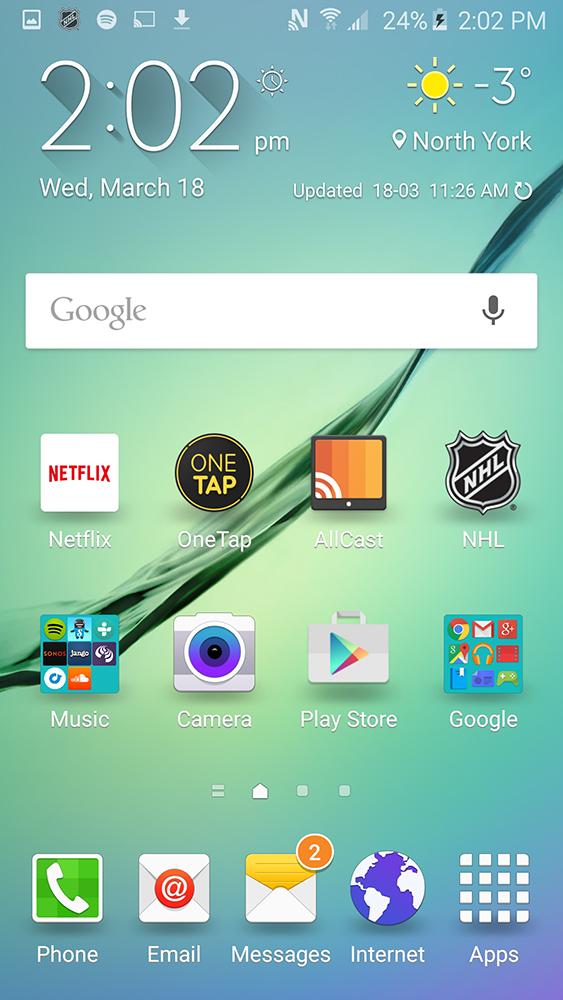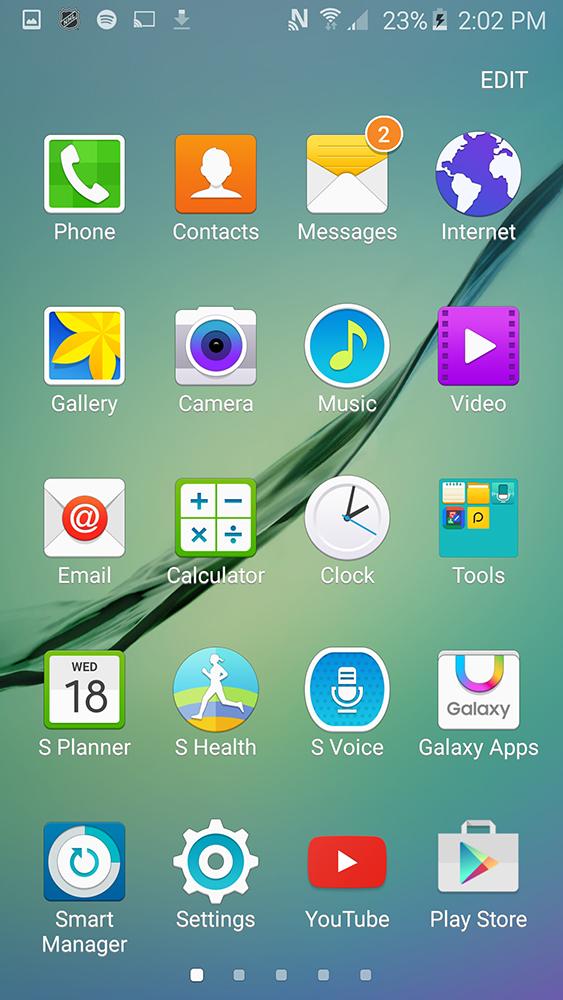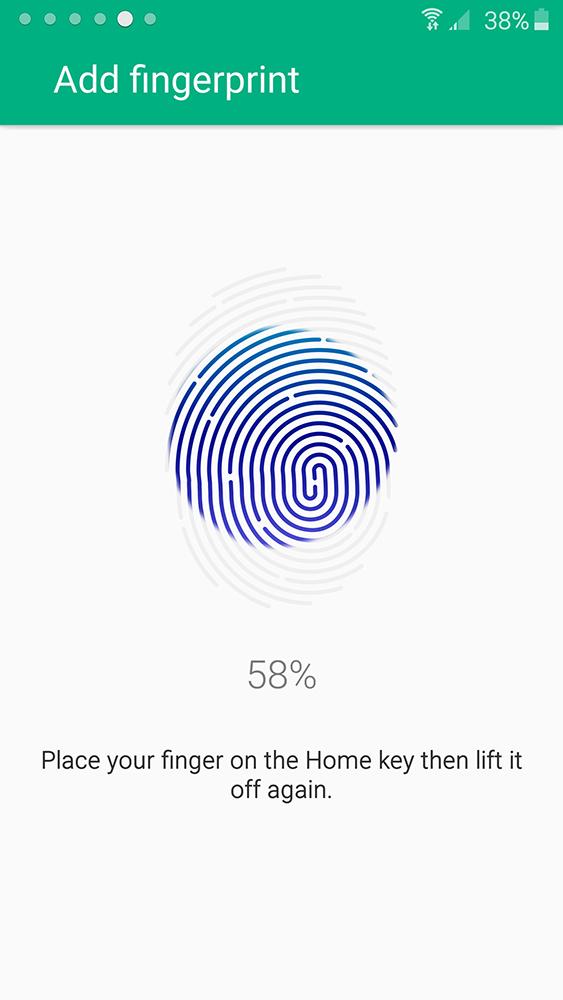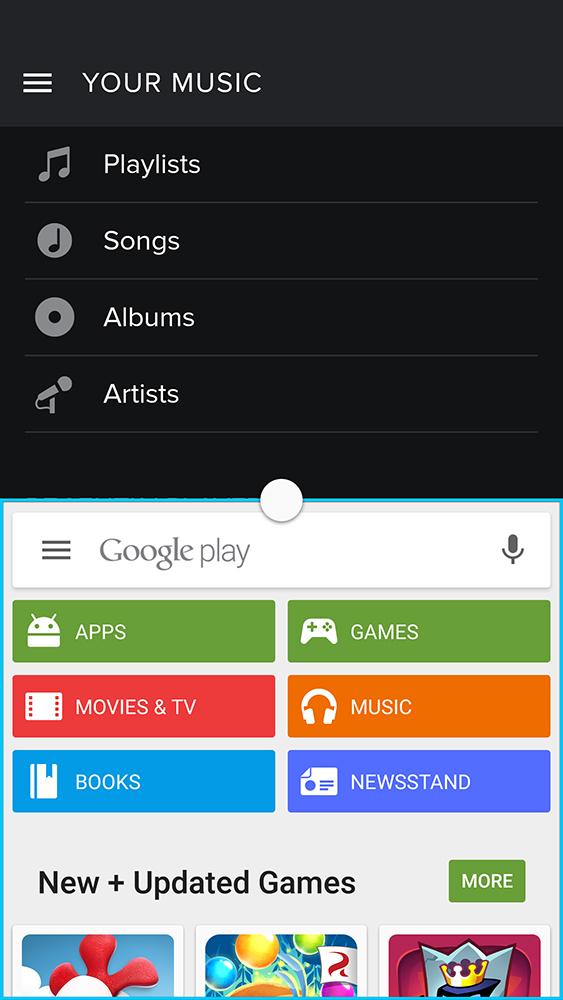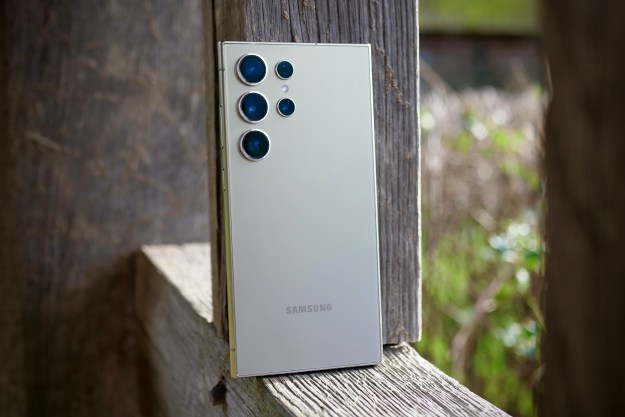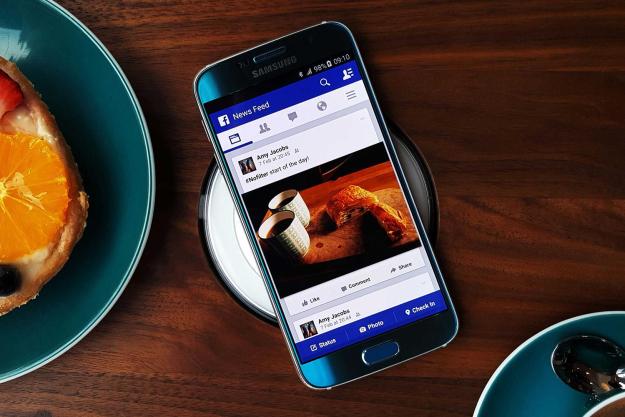
“The Galaxy S6 is the best-designed phone Samsung has ever created, and its interface is a true step ahead of the Android pack.”
- Elegant and premium build
- Gorgeous display
- Better camera features and performance
- Much-improved fingerprint reader
- Quick charging
- Supports both wireless charging standards
- No longer waterproof
- Non-removable battery
- No memory expansion
- Gets noticeably hot when pushed
- Tinny speaker sound
It should surprise no one that a year can make a world of a difference in the mobile industry. In less than 12 months, Samsung went from riding high at the top of the smartphone heap to answering for dwindling profits and questions over whether it was running out of steam.
It would be too extreme to classify the Galaxy S6 as a “savior” — Samsung isn’t in dire straits — but its importance to the company’s brand can’t be underestimated. This phone needs to be a winner. And so it’s been designed to make a statement: to instill confidence in loyal users and prove naysayers wrong.
Except this time Samsung has doubled down, offering two iterations of its vaunted flagship. With the S6 Edge as the new kid in town, is there any room for the “flat” design that put Samsung on the mobile map to begin with?
Galaxy S6 vs. Galaxy S5?

5 Best Galaxy S6 Cases

Galaxy S6 vs. HTC One M9

Look ma, no plastic!
The Galaxy S6 represents a sea change in Samsung’s design philosophy. Gone is the plastic that was signature to the Galaxy line, never truly looking refined with its faux leather and Band-Aid dimples, among other cues. This time, it’s Gorilla Glass 4 on both the front and back — an aesthetic choice with a number of consequences.
Metal fuses the two together along the edges, making room for the antennas at the top and bottom. The speaker is now at the bottom instead of the back, along with the Micro USB port. They’re joined by the headphone jack, which used to be at the top on the GS5. A microphone and IR blaster are at the top. Volume buttons (now separated instead of being together) are on the left, with the power button on the right. The SIM card slot lies just below.
Samsung had to sacrifice certain physical attributes to make this setup work. Unlike its predecessor, the Galaxy S6 isn’t waterproof, and you can’t remove or replace the 2,550mAh battery — arguably the most polarizing feature on the handset. There’s also no MicroSD card slot to expand on the internal storage. It’s hardly a surprise that the company would scrap 16GB versions and go with 32GB, 64GB, and 128GB models to offset that, since it can charge us extra (as Apple does) for upgraded models.
The Galaxy S6 isn’t waterproof, and you can’t remove or replace the 2,550mAh battery.
Comparisons to the iPhone 6 are common. When I showed the phone to a number of friends, and even strangers, it was the first competing device people mentioned by name. Considering the iPhone 6 has an aluminum shell and a slightly smaller display, it’s not entirely an apples-to-apples comparison, but perception is power. Setting aside the iPhone, Sony’s Xperia Z3 may bear the closest resemblance. The Galaxy S6 has curved corners and more metal, but they are similar.
The 5.1-inch Super AMOLED is the same size as its predecessor, except it gets a resolution bump to Quad HD (2,560 × 1,440 pixels), which gives it a density of 577 pixels per inch. Your eyes won’t be able to distinguish the millions of pixels packed into such a small frame, but suffice it to say, this is a gorgeous display and HD video looks fabulous on it.
Under the hood
The phone’s specs are an impressive mix, and the most noticeable among them is the processor. Samsung has opted to go it alone with its Exynos 7420 64-bit octa-core chip (two quad-core chips running at 2.1 GHz and 1.5 GHz, respectively). This was in spite of Qualcomm’s assertions that its Snapdragon 810 chip wasn’t prone to overheating. While the average user may not notice a difference in performance, the move may not be without some ramifications.
Having 3GB of RAM is great, considering the extra horsepower it’s supposed to complement. The same heart rate monitor introduced last year is back again in the same spot under the LED flash, though its placement can sometimes lead to smudging the rear lens as you feel for it.
Software
It’s clear with the Galaxy S6 that Samsung is starting to better understand how to utilize its own software in relation to the fruits of Android. In an effort to reduce bloat (somewhat, at least), certain features are now treated as add-ons you can download separately from the Galaxy App Store if you want them. Indeed, one peek at the Motions and Gestures section under Settings exemplifies just how far Samsung has dialed things back in only two years. The result is a much cleaner interface that’s easier to navigate.
This phone won’t be mistaken for running stock (default) Android, but Samsung’s custom TouchWiz interface doesn’t cast as long a shadow this time around. It’s a classic case of addition by subtraction. There’s less “Samsung” on the home screen, but pulling down the notification pane will look immediately familiar to any Galaxy S owner. Swipe to the right and you get Flipboard, which you can now replace with a different newsfeed app per your preference. The Settings will also look familiar, with the same menu layout as last year.
The Home button has a rejigged fingerprint sensor that is a dramatic improvement from the horrid one used in the GS5. Instead of swiping down on the button, you now only need to touch it and you’re through. The training process is also well thought out. I had to apply my thumb 10 times in different angles to capture a fuller print, thereby increasing the accuracy anytime I unlocked the phone using it. The failure rate that so frustrated me on the Galaxy S5 is gone. I got so used to using finger unlock on the Galaxy S6 that I would hold down on the button long enough to unlock and then trigger a quick Google Now command when I needed to.
Performance
There are performance caveats that I noticed early on. First, the sole speaker at the bottom, while an improvement from before, is not up to par with other devices of its caliber. The distortion became readily apparent as I ramped up the volume on anything from a YouTube video to a phone call on speaker. Second, the phone got really toasty during intensive tasks. It didn’t get hot enough to make it difficult to hold, and I didn’t see any resulting stutter or lag, but it was still more obvious than I expected.
The Galaxy S6 has a much cleaner interface that’s easier to navigate.
Despite all that, there was no questioning how fluid the overall feel of the software was. It’s got some kinks to work out, but Android Lollipop acclimated well for me here, making it easy to act on a notification by tapping it once and then unlocking with my fingerprint to bring it up. Streaming video from Plex or my local network attached storage drive was easy to manage, and casting to a Chromecast gave me no real problems.
Everyday tasks like opening apps, Web browsing, video streaming, and music playback went smoothly. I used TomTom GO with it for vehicle navigation, and it worked perfectly fine, as well. Having reviewed previous Galaxy devices, I’ve known all too well how they can be prone to acting erratically over time. My immediate impression was that the less is more approach is the best thing Samsung could have done. I like having to wade full screens of the company’s apps and services forced on me, and even in the case of Multi Window, it was a feature I only really thought off when I needed it.
Camera
The hardware and software tweaks are partially highlighted by what Samsung chose to do with the camera in this phone. A 16-megapixel rear camera and 5-megapixel front-facing camera are fine on paper, but it’s the changes complementing them that help yield tangible results. The GS5’s camera was fine during the day, but suffered terribly when shooting at night or in low light.
To remedy that, the S6’s rear f/1.9 aperture lens is wider and has optical image stabilization built-in. To help the cause, Samsung smartly made HDR automatic by default, allowing it to kick in when the sensor needs the boost to get a more composed shot. And to top it off, the camera can be launched quickly by double tapping the Home button, even when the phone is locked or asleep. It’s also ready to shoot in about a second — essential for quick snaps.
- 2. Taken with the Galaxy S6
Kudos to Samsung for keeping shooting options practical and limited. The silly modes are gone, and the ones remaining make the most sense to keep. The Pro mode is sort of a mixed bag, though. It’s great that you can adjust ISO, white balance, metering and add effects, but the results don’t always jive with the choices you make. It would’ve been interesting if shutter speed was included, but even if it was, it’s not enough to put the mode over the top.
That being said, I was generally pleased with the shots the phone took. It was definitely better in macro than the GS5, and low-light images were more detailed with better illumination and contrast. I can also say the same about shooting video, where 2K and 4K modes are available. You still have to exercise some caution when shooting in either of those because they incur huge file sizes, and without a memory card to save to, you would have to offload them quickly to a computer or cloud storage backup.
Battery life
The battery is really the key to the Galaxy S6. If it whittles down quickly, the phone’s features and performance hold less credence. The Galaxy S6 actually has a smaller battery (2,550mAh) than the GS5 (2,800mAh), but it’s supposed to use a more efficient processor. The jury’s still out on the Exynos chip, but questioning the longevity of the non-removable battery is totally understandable.
Samsung flatly noted that it only went with the non-removable design because it was confident the battery could stand up on its own. Well, that confidence has a backup plan, just in case. The Quick Charger that comes in the box with the phone can give you four hours of use (or two hours of HD streaming) from a fast 10-minute charge. Samsung says it can charge from empty to full in only 80 minutes. I wasn’t provided with the proper charger, so I can’t verify that those numbers are indeed accurate.
The second part of that plan is wireless charging support for both the Qi and PMA (Power Matters Alliance) standards. This is the first smartphone to have dual compatibility, so it’s a big deal if you own a wireless charger. I tried to charge it on an old Powermat charger (which used PMA technology) but it didn’t work. It did work like a charm on a Qi pad, however.
Charging options aside, the battery’s overall performance didn’t impress me. I could go through a full day, except it drained faster than I expected. This isn’t to say that it’s awful and a major cause for concern, just that it isn’t as robust as it should be. In some respects, I consider the GS5 to last longer than this phone does.
Conclusion
I won’t speculate on how many units Samsung will sell, but while testing the Galaxy S6, I did ponder whether consumers would leave it behind in favor of the S6 Edge. I imagine Samsung is curious as well because if the Edge wins out by a fat margin, this may be the swan song for the “flat” model.
The DT Accessory Pack
Up your game and the get the most out of your gear with the following extras, hand-picked by our editors:
rooCASE Galaxy S6 Case ($16)
Samsung Mini Qi wireless charging pad ($50)
ReTrak wired selfie stick ($20)
Regardless, for the first time, the Galaxy S line has what can best be described as a “premium” design. This is an elegant handset, in many ways, and it helps that the methodically understated software approach doesn’t distract from that. An improved fingerprint scanner and effective quick draw for the camera are the kind of sensible usability features Samsung needs to do more of.GS5 owners may hesitate to upgrade, especially if they value the removable battery, but those using an S4 or earlier will find a much better experience here. And while the S6’s battery isn’t exemplary, it’s a far cry from the issues the S4 suffered from after months of usage. Samsung put together a device that its faithful will no doubt appreciate, and newcomers or deserters should also give it more than a passing glance.
Highs
- Elegant and premium build
- Gorgeous display
- Better camera features and performance
- Much-improved fingerprint reader
- Quick charging
- Supports both wireless charging standards
Lows
- No longer waterproof
- Non-removable battery
- No memory expansion
- Gets noticeably hot when pushed
- Tinny speaker sound
Available at: AT&T Sprint T-Mobile Verizon
Editors' Recommendations
- Best Samsung Galaxy Z Fold 4 deals: Grab the foldable phone for $700
- Samsung has a new (and cheaper) way to buy the Galaxy S23
- Samsung Galaxy Ring: news, rumored price, release date, and more
- The 20 best Samsung Galaxy Watch faces you should be using
- A surprise phone just beat the Galaxy S24 Ultra in a big way






